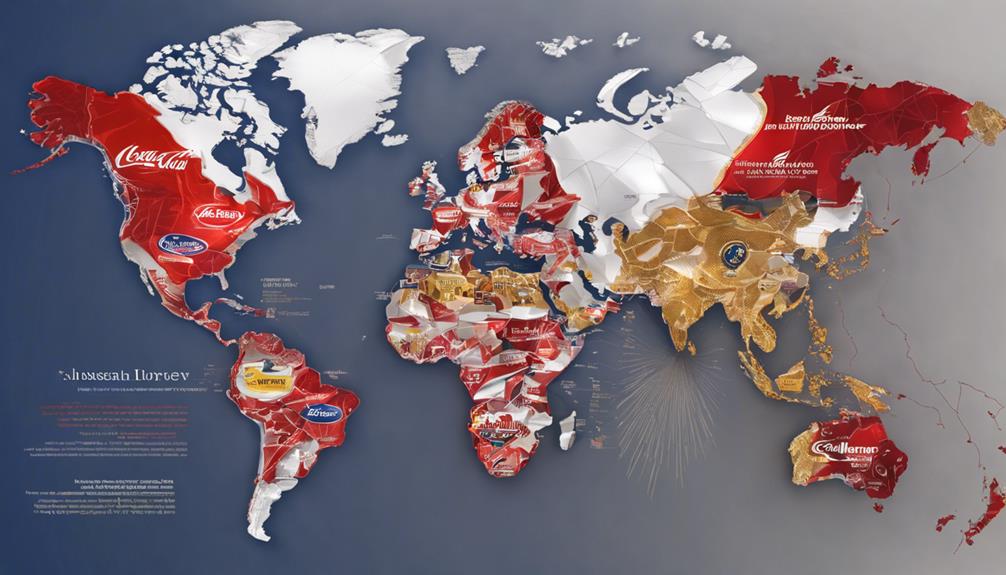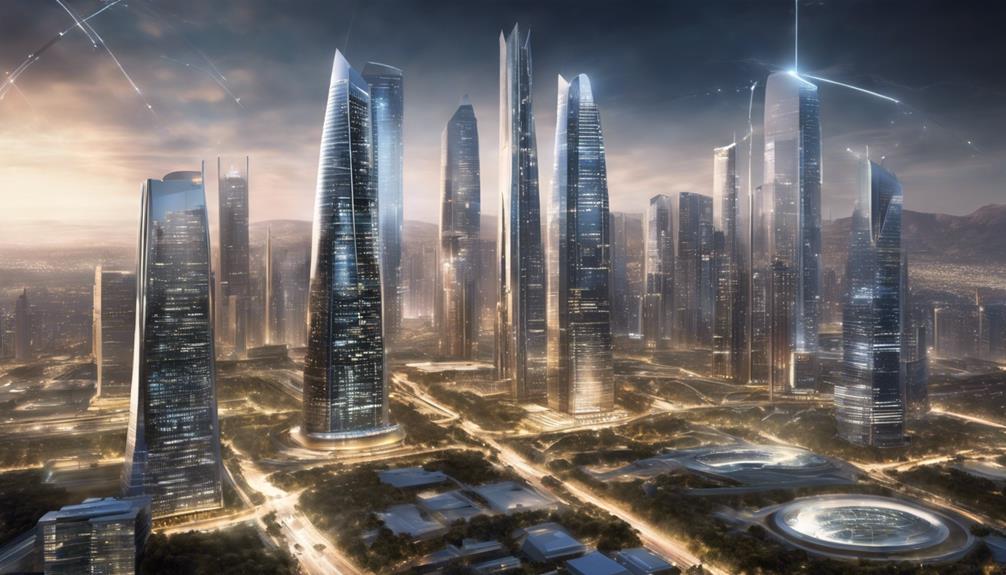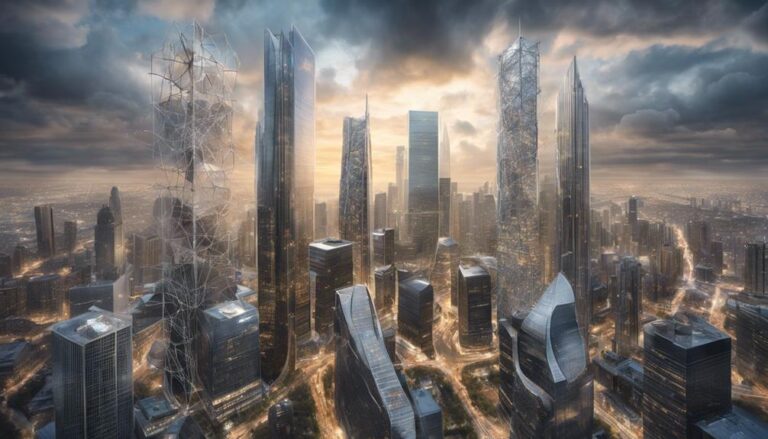Case Studies: Successful Conglomerate Mergers

Successful conglomerate mergers have the potential to revolutionize industries and generate impressive returns when executed effectively. Let's explore some notable examples that exemplify the impact of these transformative corporate unions.
Disney's acquisition of Pixar seamlessly integrated cutting-edge animation technology with unparalleled storytelling prowess. In a similar vein, General Electric's acquisition of NBC Universal diversified its business portfolio significantly.
Johnson & Johnson's strategic purchase of Actelion enhanced its pharmaceutical capabilities, while Berkshire Hathaway's acquisition of BNSF Railways fortified its position in the transportation sector. These strategic mergers capitalized on synergies, improved operational efficiencies, and enhanced competitive advantages.
Delving deeper into these insightful case studies can provide valuable lessons for driving sustainable growth in conglomerates.
Key Takeaways
Successful conglomerate mergers, like the union of Disney and Pixar, and GE's acquisition of NBC Universal, strategically combined expertise and technologies to boost competitiveness and profitability. These mergers capitalized on synergies, where the strengths of one company complemented the weaknesses of the other, resulting in a stronger, more diversified business entity.
Acquisitions have been instrumental in helping companies diversify their portfolios, expand product lines, and solidify market positions. For instance, the merger of Merck and Schering-Plough, as well as Pfizer's acquisition of Wyeth, enabled these pharmaceutical giants to broaden their product offerings, reach new markets, and optimize operational efficiencies.
One of the main challenges in conglomerate mergers is integrating corporate cultures and aligning operational processes. However, successful mergers have overcome these obstacles by focusing on cross-promotion, delivering a unified customer experience, and streamlining operations to realize cost savings and enhance overall performance.
In industries like agriculture, energy, and aerospace, conglomerate mergers have led to the creation of industry powerhouses. Examples include the merger of Bayer and Monsanto, as well as Lockheed Martin's acquisition of Sikorsky, which have resulted in companies with extensive technological capabilities and market dominance.
Large-scale acquisitions, such as Berkshire Hathaway's purchase of BNSF Railway and Anheuser-Busch InBev's merger with SABMiller, have provided stable cash flows, long-term growth opportunities, and operational synergies for the merged entities. These mergers have proven to be strategic moves that drive growth and profitability in the long run.
Disney's Acquisition of Pixar
Disney's acquisition of Pixar in 2006 for $7.4 billion united two entertainment giants, merging Pixar's cutting-edge animation technology and storytelling expertise with Disney's creative prowess. This strategic union solidified Disney's leadership in the animation industry, expanding its market reach and strengthening its competitive advantage.
The collaboration between Disney and Pixar resulted in the creation of many successful films, including iconic favorites like 'Toy Story,' 'Finding Nemo,' and 'The Incredibles.' By leveraging Pixar's specialized skills, Disney was able to craft compelling stories and stunning visuals that captivated audiences globally, reinforcing its position as a top provider of family-friendly entertainment.
One significant outcome of the deal was Steve Jobs, Pixar's co-founder, becoming the largest individual shareholder in Disney, solidifying his influential role in both companies. This acquisition showcases how synergistic conglomerate mergers can combine complementary strengths, fostering innovation and propelling growth in the dynamic entertainment landscape.
General Electric's Acquisition of NBC Universal

General Electric acquired NBC Universal to create a diversified powerhouse by combining their respective strengths. GE aimed to leverage NBC Universal's expertise in media while maintaining its focus on core industrial operations. The merger posed integration challenges, but the synergies between the two entities ultimately led to significant benefits.
Conglomerate mergers like the one between General Electric and NBC Universal involve companies from different industries coming together to create a more diversified business portfolio. This type of merger allows companies to access new markets, technologies, and capabilities that they may not have had on their own.
By joining forces with NBC Universal, General Electric expanded its presence in the media and entertainment industry, diversifying its revenue streams and reducing its dependence on its traditional industrial businesses. This move allowed GE to tap into new sources of growth and innovation, strengthening its overall position in the market.
Despite the integration challenges that arose during the merger process, such as aligning corporate cultures and combining different business models, the collaboration between General Electric and NBC Universal ultimately proved successful. The combined entity was able to capitalize on the complementary strengths of both organizations, leading to increased efficiency, profitability, and market competitiveness.
Rationale for Acquisition
We decided to acquire NBC Universal, a prominent media and entertainment company, for $30 billion in 2009 to broaden GE's industrial portfolio. This move allowed us to explore successful conglomerate mergers and tap into new revenue streams.
There were four main reasons for this acquisition:
- Diversifying our business offerings beyond traditional industrial products.
- Utilizing NBC Universal's strong presence in television and film to expand our portfolio.
- Capitalizing on synergies between GE's technological expertise and NBC Universal's content creation capabilities.
- Establishing ourselves as a more diverse and balanced conglomerate, better equipped to navigate the changing business environment.
The merger process was intricate, but the successful integration of NBC Universal into GE's operations has showcased the potential for GE to execute a strategic shift towards a more diversified business model.
Integration Challenges
When General Electric acquired NBC Universal, they faced the challenge of integrating two very different corporate cultures. GE, known for its focus on engineering and industrial manufacturing, had a culture distinct from NBC Universal's creative and entertainment-oriented mindset. To successfully merge the two businesses, it was essential to find a balance between these contrasting cultures.
To tackle the integration obstacles, the focus was on finding common ground between the two companies. Both GE and NBC Universal shared a commitment to innovation and excellence, which served as a foundation for aligning their operations. By leveraging GE's technological expertise with NBC Universal's content creation capabilities, the merged entity could explore new avenues in media and entertainment.
Aligning operational processes, management styles, and strategic priorities was crucial in maximizing the benefits of the merger. By carefully harmonizing these aspects, the conglomerate could capitalize on synergies and drive growth in the competitive industry. Despite the challenges faced during the integration process, the belief in the potential for substantial synergies kept the team motivated.
Synergies Realized
General Electric's acquisition of NBC Universal in 2009 for $30 billion unlocked a myriad of synergies that significantly benefited the conglomerate. Through this strategic merger, we harnessed a range of advantages:
- Synergy through Cross-Promotion: By combining GE's industrial prowess with NBC Universal's media assets, we crafted innovative cross-promotional strategies that elevated brand recognition and customer engagement across various platforms.
- Seamless Content Integration: The integration of NBC Universal's entertainment and news content with GE's diverse portfolio resulted in a more compelling and unified customer experience, enhancing our competitive edge in the market.
- Enhanced Media Expertise: Leveraging NBC Universal's extensive media expertise catapulted the merged entity into a prominent position within the dynamic media and entertainment landscape, paving the way for sustained growth and innovation.
- Streamlined Industrial Operations: Simultaneously, the acquisition allowed GE to sharpen its focus on core industrial operations while tapping into the synergies and growth prospects presented by NBC Universal's valuable media and entertainment assets.
Alphabet's Acquisition of Nest

In 2014, Alphabet completed the acquisition of Nest for a substantial $3.2 billion, marking a strategic move into the burgeoning smart home technology market. Nest, renowned for its cutting-edge thermostats and smoke detectors, synergized perfectly with Alphabet's diverse tech portfolio. This acquisition allowed Alphabet to strengthen its foothold in the rapidly expanding Internet of Things (IoT) sector, which was poised for significant growth.
Following the acquisition, Nest continued to operate as an independent entity within Alphabet, preserving its unique brand identity. Alphabet capitalized on Nest's expertise and resources in smart home technology to enrich its own product lineup and market reach. This collaborative partnership proved instrumental in meeting the escalating consumer interest in intelligent, interconnected home devices.
The acquisition of Nest exemplified Alphabet's strategic approach to growth through targeted acquisitions of promising technology firms. By integrating Nest's innovative solutions, Alphabet reinforced its position as a frontrunner in the smart home revolution, positioning itself as a key player in the evolving landscape of connected devices.
Johnson & Johnson's Acquisition of Actelion

Let's dive into Johnson & Johnson's game-changing acquisition of the Swiss biopharmaceutical company Actelion. This monumental $30 billion deal marked a significant move for J&J into the realm of conglomerate mergers, broadening its horizons and diversifying its product portfolio.
By absorbing Actelion's cutting-edge medications, particularly in the niche rare disease market, J&J positioned itself as a formidable player in the pharmaceutical industry.
This strategic acquisition not only bolstered J&J's offerings but also paved the way for synergies between the two companies. Actelion's specialized research and development capabilities complemented J&J's existing strengths, creating a powerhouse of innovation and growth potential.
The conglomerate merger aimed to leverage Actelion's unique expertise to drive forward momentum and solidify J&J's foothold in the competitive pharmaceutical landscape.
Pharmaceutical Powerhouse Synergy
Johnson & Johnson's acquisition of Actelion in 2017 highlighted the strategic synergy between the two pharmaceutical giants. This merger enabled Johnson & Johnson to tap into Actelion's strong portfolio of drugs for pulmonary arterial hypertension, expanding its offerings in the rare disease market.
The merger benefited both companies in various ways. Actelion's expertise in research and development complemented Johnson & Johnson's resources, leading to the creation of innovative drugs. By integrating Actelion's talent and technologies, Johnson & Johnson enhanced its ability to address unmet medical needs effectively.
Furthermore, the acquisition strengthened Johnson & Johnson's position as a leader in the pharmaceutical industry. It diversified the company's product pipeline and revenue streams, solidifying its presence in the market. Acquiring Actelion's market-leading pulmonary hypertension drugs further established Johnson & Johnson's dominance in the therapeutic area.
This conglomerate merger exemplified how combining the strengths of two pharmaceutical powerhouses can result in significant benefits and advancements in the industry.
Bolstering Rare Disease Portfolio
Expanding its rare disease portfolio, the acquisition of Actelion by Johnson & Johnson significantly enhanced J&J's presence in the pulmonary arterial hypertension market. Actelion's strong rare disease products, especially its leading pulmonary arterial hypertension medications, complemented Johnson & Johnson's pharmaceutical division perfectly. This strategic move solidified J&J's position as a top player in rare disease treatments.
By keeping Actelion's focus on independent research and development intact, Johnson & Johnson swiftly increased its footprint in the rapidly growing rare disease sector. This acquisition not only strengthened J&J's pharmaceutical offerings but also expanded access to innovative therapies for patients grappling with severe conditions.
Leveraging Actelion's exceptional capabilities, Johnson & Johnson is well-positioned to make significant strides in addressing the unmet needs of individuals with rare diseases.
Berkshire Hathaway's Acquisition of Burlington Northern Santa Fe

In 2009, Berkshire Hathaway made a significant acquisition by purchasing the Burlington Northern Santa Fe (BNSF) railway for $27 billion. This move solidified Berkshire Hathaway's position in the transportation industry. Led by Warren Buffett, this strategic decision was a long-term investment in the future of railroads.
The acquisition of BNSF provided Berkshire Hathaway with several advantages. Firstly, it brought stable cash flows from BNSF's reliable operations. Secondly, it offered the potential for long-term growth in the transportation sector. Thirdly, it diversified Berkshire Hathaway's already impressive portfolio. Lastly, it created synergies and operational efficiencies through integration.
The Berkshire Hathaway-BNSF acquisition exemplifies a conglomerate merger, where a large company acquires a smaller one to diversify its business operations. This type of merger is common in industries like transportation, where companies seek to expand their reach and capabilities.
The success of this acquisition can be attributed to Berkshire Hathaway's strategic vision and Warren Buffett's leadership in making bold investment decisions.
Merck's Acquisition of Schering-Plough

Merck's acquisition of Schering-Plough in 2009, valued at $41.1 billion, was a significant move that reshaped the pharmaceutical industry. This merger between the two giants aimed to expand Merck's product portfolio by incorporating key drugs like Remicade and Nasonex from Schering-Plough. By doing so, Merck solidified its position as a dominant player in the market.
Additionally, the merger provided Merck with access to Schering-Plough's strong consumer healthcare and animal health divisions, broadening the company's range of offerings. The consolidation also resulted in substantial cost-saving synergies and operational efficiencies, ultimately boosting the competitiveness of the newly formed entity.
This conglomerate merger not only enhanced Merck's innovative capabilities but also established it as a formidable presence in the pharmaceutical sector. By effectively combining their strengths and maximizing synergies, the merger between Merck and Schering-Plough stands as a strategic feat that showcases the benefits of well-executed mergers and acquisitions in the industry.
Pfizer's Acquisition of Wyeth

Pfizer's acquisition of Wyeth in 2009 significantly boosted the company's research capabilities and product offerings.
By incorporating Wyeth's strengths in biotechnology, vaccines, and consumer healthcare, Pfizer successfully navigated the challenges of merging the two companies and seized opportunities for revenue growth in the global pharmaceutical sector.
This strategic decision firmly established Pfizer as a prominent player in the industry, enhancing its competitive position and market presence.
Synergistic Research Capabilities
Pfizer's acquisition of Wyeth in 2009 brought together their strengths in pharmaceuticals and biotechnology, enhancing research capabilities and driving innovation in drug development. By combining Pfizer's pharmaceutical expertise with Wyeth's biotechnology prowess, the merger unlocked powerful synergies in research and development.
This collaboration enabled the integration of diverse scientific knowledge to develop novel therapeutic approaches, accelerate drug candidate discovery, and streamline the drug development process for cost savings.
The merger also led to the expansion of product portfolios and increased market presence in key therapeutic areas. The reinforced research infrastructure resulting from the successful merger fueled the creation of innovative drugs, strengthening competitive edge and improving operational efficiency.
This strategic conglomerate merger showcases how identifying and effectively utilizing synergies can generate significant value in the pharmaceutical industry.
Integration Challenges Overcome
Integrating Pfizer's and Wyeth's different research and sales teams posed significant challenges, but we successfully overcame these obstacles through strategic coordination and a strong commitment to collaboration. Bringing together the distinct research and development efforts of the two companies required meticulous planning and transparent communication to ensure a seamless transition.
Combining the sales forces was a complex task that involved aligning their varied approaches and establishing cohesive goals. Addressing the cultural differences between the organizations was also crucial for a successful integration process.
Managing the overlapping product portfolios demanded careful attention as we focused on streamlining operations and capturing cost-saving synergies.
Throughout the integration journey, our unwavering dedication to leveraging the complementary strengths of both companies enhanced Pfizer's global presence and solidified its position as a leading pharmaceutical powerhouse.
Revenue Growth Opportunities
Pfizer's acquisition of Wyeth in 2009 for $68 billion significantly enhanced its revenue growth opportunities. The merger enabled Pfizer to diversify its revenue streams and broaden its product portfolio, particularly in the biotech, vaccines, and consumer healthcare sectors, where Wyeth had established a strong presence.
The acquisition granted Pfizer access to Wyeth's successful drugs like Enbrel and Prevnar, leading to a substantial increase in revenue post-merger. This strategic move also facilitated cost synergies through operational efficiencies, expanded market reach, and seamless integration of Wyeth's product lines into Pfizer's existing portfolio.
Moreover, the combined company's enhanced capabilities created new revenue opportunities and strengthened its position in the competitive pharmaceutical landscape.
Anheuser-Busch InBev's Acquisition of SABMiller

Anheuser-Busch InBev's acquisition of SABMiller in 2016 transformed the global beer industry by forming a conglomerate powerhouse. This merger brought together a vast collection of over 400 well-known beer brands, creating a dominant presence in the market. The $104.2 billion deal resulted in substantial cost savings and operational efficiencies through synergies and economies of scale.
By joining forces, Anheuser-Busch InBev and SABMiller expanded their reach into emerging markets, positioning themselves to take advantage of growth opportunities in developing regions. The diverse portfolio of iconic beer brands now under the conglomerate's umbrella solidifies its brand strength and market position.
The integration of operations post-merger hasn't only streamlined the business but also improved profitability for the conglomerate. This strategic move has bolstered Anheuser-Busch InBev's standing as a leading player in the global beer industry, creating value for both shareholders and consumers.
Siemens' Acquisition of Dresser-Rand

Siemens' acquisition of Dresser-Rand in 2014 for $7.6 billion was a significant conglomerate merger that reshaped the oil and gas industry. By adding Dresser-Rand's expertise in energy equipment and services to its portfolio, Siemens strengthened its position in the sector.
Dresser-Rand's established presence in the LNG and oil markets complemented Siemens' existing offerings in power generation and industrial automation, creating a well-rounded portfolio. Siemens saw an opportunity to leverage Dresser-Rand's innovative technologies and global reach to drive growth in the energy market, marking a strategic move for the company.
The merger not only expanded Siemens' footprint in the oil and gas industry but also enhanced its portfolio with Dresser-Rand's specialized expertise. This allowed Siemens to offer a comprehensive range of solutions in the energy and automation sectors, solidifying its position as a leading provider in the industry.
Bayer's Acquisition of Monsanto

Bayer's purchase of Monsanto in 2018 for $63 billion formed a powerhouse in the agricultural technology and seed industry. The merger underwent substantial scrutiny from regulators due to concerns about market competition and potential environmental impacts. Nevertheless, our aim was to harness the combined expertise of Bayer and Monsanto in agriculture, biotechnology, and crop protection to better serve farmers globally.
Despite facing challenges, especially regarding legal settlements related to glyphosate-based herbicides like Roundup, the acquisition positioned us as a major player in the global agriculture sector. We now provide a diverse range of cutting-edge products and services to help farmers enhance their productivity and sustainability.
Integrating the strengths of these two industry giants has been crucial to our success as we drive advancements in agricultural technology that benefit growers and the environment. Our focus remains on responsibly delivering solutions that cater to the changing needs of modern agriculture.
Novartis' Acquisition of GlaxoSmithKline's Oncology Business

In 2015, Novartis made a strategic move to strengthen its oncology portfolio by acquiring GlaxoSmithKline's cancer business for $16 billion. This acquisition included key products like Votrient and Tykerb, along with promising development programs. The goal was to enhance Novartis' position in the competitive oncology market, expand its treatment options for cancer patients, tap into GlaxoSmithKline's advanced research and development capabilities, and pave the way for future growth and innovation in the oncology sector.
This conglomerate merger allowed Novartis to solidify its presence as a major player in the oncology market, giving it a competitive edge in offering a wider range of cancer treatments. By acquiring GlaxoSmithKline's oncology assets, Novartis gained access to new technologies and research initiatives that could potentially lead to groundbreaking advancements in cancer therapy.
This strategic acquisition aligns with the trend of conglomerate mergers in the pharmaceutical industry, where companies seek to diversify their portfolios and enhance their capabilities through strategic acquisitions.
Marriott's Acquisition of Starwood Hotels

Marriott's purchase of Starwood Hotels in 2016 for $13.6 billion formed the world's largest hotel chain, incorporating more than 5,800 hotels and 1.1 million rooms into our collection. This merger extended our global footprint, especially in the upscale and contemporary hospitality sectors, allowing us to capitalize on synergies that resulted in cost efficiencies and enhanced market presence.
Bringing together the combined entity's 30 brands, such as Marriott, Sheraton, and Ritz-Carlton, presented a challenging yet fruitful endeavor. Leveraging our expanded scope and varied offerings positions us to foster innovation and provide unparalleled guest experiences on a global scale.
The successful completion of this acquisition showcases our dedication to strategic expansion and our adeptness in managing the intricacies of conglomerate mergers. Establishing the industry's foremost hospitality platform underscores our prominence as a frontrunner in the international travel and tourism industry.
Danaher's Acquisition of Pall Corporation

In 2015, Danaher acquired Pall Corporation for $13.8 billion, solidifying our position as a conglomerate in the life sciences and diagnostics industry. This strategic move expanded our portfolio of solutions for biopharmaceutical and industrial applications, enhancing our presence in key sectors and strengthening our position as a leading provider of innovative solutions.
The integration of Pall Corporation brought about increased revenue and market share, allowing us to expand our reach and capabilities in the life sciences and diagnostics markets. By combining our expertise, we improved our ability to serve customers with a more extensive range of products and services, positioning us as a key player in the industry.
As we look towards the future, we're committed to driving innovation and delivering value to our stakeholders. By identifying synergies and leveraging our combined strengths, we'll continue to explore strategic opportunities to stay ahead of the curve and maintain our position as a leader in the field.
Broadcom's Acquisition of CA Technologies

In Broadcom's acquisition of CA Technologies, we focus on why the deal was strategic, the hurdles encountered during integration, and how the combined entity leveraged synergies to strengthen its market position.
Broadcom's decision to expand beyond semiconductors and tap into CA's client base and recurring revenue streams was crucial. Despite initial doubts, the merger needed skillful execution to deliver the anticipated advantages.
Ultimately, integrating CA's products into Broadcom's lineup led to cost efficiencies and improved product offerings, cementing the success of the merger.
Strategic Rationale
Broadcom aimed to expand its business beyond semiconductors and enhance its enterprise software capabilities by acquiring CA Technologies for $18.9 billion in 2018. This move was part of Broadcom's strategy to become a prominent player in infrastructure technology. By merging with CA Technologies, Broadcom could offer a wider range of solutions in the enterprise software sector.
The primary reasons for this acquisition were to enter new markets and broaden Broadcom's revenue sources beyond semiconductors. By integrating CA Technologies' well-established enterprise software business, Broadcom could secure a more stable revenue stream. Leveraging CA Technologies' expertise and customer base also enabled Broadcom to solidify its position in the enterprise software market and provide comprehensive infrastructure technology solutions to its clients.
Integration Challenges
Integrating Broadcom's acquisition of CA Technologies presented a significant challenge due to the cultural differences and product overlap between the two organizations. Broadcom had to address concerns from CA Technologies' employees and customers who were wary of the impending changes.
The integration process involved restructuring and streamlining operations to create synergies, a task that required careful planning and execution. Bringing together distinct corporate cultures and aligning diverse product lines necessitated a nuanced approach and a deep understanding of the complexities involved.
Despite the hurdles, Broadcom remained committed to its strategic goal of expanding beyond semiconductors. By tackling the integration obstacles head-on, the company aimed to unlock the full potential of the acquisition and position the combined entity for sustained success.
In navigating the intricate landscape of cultural differences and overlapping product portfolios, Broadcom showcased its proficiency in managing successful conglomerate mergers. This experience laid a solid foundation for future growth and innovation within the organization.
Synergy Realization
Broadcom's $18.9 billion acquisition of CA Technologies succeeded in realizing synergies by tapping into CA Technologies' expertise in mainframe and infrastructure software. This move not only expanded the customer base but also enriched the product offerings to better cater to enterprise clients. By venturing into the profitable enterprise software market, Broadcom diversified its portfolio beyond the semiconductor business.
The synergy realization was pivotal in the triumph of this conglomerate merger. Firstly, cross-selling opportunities emerged as CA Technologies' software solutions were introduced to Broadcom's existing customer base, opening up new revenue streams. Secondly, significant cost savings were achieved through operational efficiencies by streamlining operations and consolidating shared functions.
Thirdly, the acquisition broadened the customer base by providing access to a fresh set of enterprise customers, reinforcing market presence. Lastly, integrating CA Technologies' proficiency in mainframe and infrastructure software enabled the creation of more comprehensive and compelling solutions for clients.
In essence, the successful synergy realization resulting from this conglomerate merger underscored Broadcom's capacity to generate value through strategic acquisitions.
Lockheed Martin's Acquisition of Sikorsky Aircraft

In 2015, Lockheed Martin made a significant move by acquiring Sikorsky Aircraft for $9 billion. This strategic decision aimed to strengthen Lockheed Martin's presence in the aerospace and defense industry by expanding its product range and market reach. By bringing Sikorsky's expertise in military and commercial helicopters under its umbrella, Lockheed Martin solidified its position in the rotorcraft market.
The acquisition of Sikorsky Aircraft brought about synergies that allowed for continuous growth and innovation within Lockheed Martin. This conglomerate merger enabled the company to leverage Sikorsky's capabilities and knowledge in helicopter manufacturing, enhancing its technological offerings and market competitiveness.
Furthermore, the acquisition of Sikorsky helped Lockheed Martin diversify its product portfolio by incorporating specialized helicopter expertise into its existing lineup. This diversification strategy not only expanded the company's range of offerings but also strengthened its overall market position in the aerospace and defense sector.
The successful integration of Sikorsky Aircraft into Lockheed Martin's operations showcased the benefits of this conglomerate merger. By seamlessly combining resources and expertise, the acquisition proved to be a valuable investment that bolstered Lockheed Martin's technological capabilities and market presence in the ever-evolving aerospace and defense industry.
Frequently Asked Questions
What Is a Real Life Example of a Conglomerate Merger?
We can observe how strategic planning, resource allocation, and diversification strategies play a pivotal role in driving successful conglomerate mergers like Alphabet's acquisition of Nest. This acquisition exemplifies the potential for synergy and innovation that can result from overcoming integration challenges and clashes in organizational culture.
One real-life example of a conglomerate merger is the merger between The Walt Disney Company and 21st Century Fox. This merger allowed Disney to expand its content library, strengthen its position in the entertainment industry, and gain access to Fox's valuable intellectual property. By leveraging their combined resources and expertise, the two companies were able to create a powerful and diversified entertainment conglomerate that could compete more effectively in the rapidly evolving media landscape.
Which Company Is the Best Example of a Conglomerate?
When it comes to conglomerate mergers, Berkshire Hathaway stands out as a prime example of a diversified corporate powerhouse. Led by Warren Buffett, this sprawling empire has shown exceptional prowess in managing risks, expanding internationally, and fostering innovation, making it a shining beacon of conglomerate excellence.
Berkshire Hathaway's strategic approach to mergers and acquisitions has enabled them to diversify their portfolio across various industries, from insurance and utilities to retail and manufacturing. This broad scope not only mitigates risks but also allows them to capitalize on different market trends and economic conditions.
Moreover, Berkshire Hathaway's global reach has positioned them as a key player in the international business landscape. By expanding their operations beyond borders, they have been able to tap into new markets, leverage diverse talent pools, and access a wider customer base, further solidifying their status as a conglomerate leader.
In terms of innovation, Berkshire Hathaway has demonstrated an ability to adapt to changing times and embrace new technologies. By staying ahead of the curve and constantly seeking out opportunities for growth and improvement, they have managed to stay relevant and competitive in an ever-evolving business environment.
What Is the Most Successful Merger of All Time?
In the realm of mergers and acquisitions, Disney's $7.4 billion acquisition of Pixar in 2006 stands out as a shining example of a successful conglomerate merger. This strategic move allowed Disney to tap into Pixar's innovative storytelling and animation expertise, propelling them to the forefront of the entertainment industry.
By combining Disney's vast resources and distribution channels with Pixar's creative genius, the merger resulted in a powerhouse that produced iconic films like "Toy Story," "Finding Nemo," and "The Incredibles." These films not only captured the hearts of audiences worldwide but also dominated the animation market, solidifying the merged entity's position as a leader in the industry.
Through effective management of the complex structure created by the merger, Disney was able to diversify its portfolio, attract top talent, and continue to innovate in the ever-evolving world of animation. This successful integration of two powerhouse companies set a new standard for conglomerate mergers and paved the way for future collaborations in the entertainment industry.
Which Is the Most Popular Conglomerate in the World?
General Electric stands out as the top conglomerate globally, known for its extensive range of businesses that leverage the benefits of diversification, growth strategies, and synergies. This conglomerate excels in navigating the complexities of the regulatory landscape by introducing innovative solutions.
In the realm of conglomerate mergers, General Electric's strategic acquisitions and mergers have propelled its growth and dominance in various industries. By diversifying its portfolio through mergers with complementary businesses, General Electric has strengthened its competitive position and expanded its market reach.
Through a series of well-planned mergers, General Electric has managed to create a robust ecosystem of interconnected businesses that work together to drive value and profitability. These conglomerate mergers have allowed General Electric to tap into new markets, access diverse sources of revenue, and enhance its overall resilience against market fluctuations.
Conclusion
We've explored a variety of successful conglomerate mergers, each providing valuable insights. Despite their differences, a common theme emerges – the ability to carefully integrate complementary businesses, harnessing synergies to fuel growth and enhance shareholder value.
These case studies illustrate that with a strategic vision, disciplined execution, and a sharp focus on cultural fit, companies can navigate the complexities of M&A to achieve transformative results. While the journey may present challenges, the potential rewards are significant for those who navigate it diligently.





